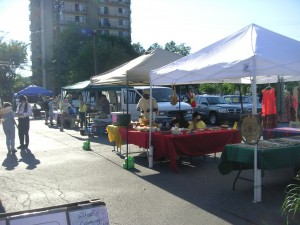Rachel and I went to graduate school at the University of Michigan’s School of Natural Resources and Environment to learn to change the world. We each partnered our MS from SNRE with a masters degree from another school. Emily- Ross School of Business and Rachel- School of Public Health. Along the way we learned a lot about organizational theory and behavior change and reasonable people as presented in SNRE, Public Health or B-school. In this marvelous mess of learning we also realized that there are many ways to describe the process of world-changing. Some are easier to visualize, more helpful, than others.
The one that stuck with us came from an article we read in NRE 580 as offered in winter ’08. Good thing this article came the first day of class, because we actually read it. The article, “From Complex Regions to Complex Worlds” was written by C.S. Hollings. It depicted change as an infinity symbol – things start at a low point, gradually building up to an apex, only to flip or crash to a new low point… over and over again. But it also showed change happening on several scales – a HUGE infinity symbol, where things move slowly, representing global institutions; a medium-sized one for smaller institutions like universities and local governments, and the smallest infinity representing small groups in which major change can happen literally overnight. And these levels interact- when the big infinity flips, change cascades down to the lower levels… and when the smallest infinity moves, it propels upper-level change.
If you decouple the theory from institutions, you can see the analogs everywhere on an individual scale: individual–> friend group–> organization or daughter–> parents–> extended family and so on.
The image was so sticky because it actually captured the flow of change and the relationship between slow moving, large scale and fast moving, small scale institutions. As society presses on toward a sustainable future, it needs fast moving change agents at the small scale, and slower moving (careful) change agents at the global scale – and each must be learning from and reacting to the other.
Taking this to a personal level, it made clear and less contentious the conversations about “What is most important to do” between environmental activists who are more policy-oriented and those who are align more with small-scale local initiatives. Neither of them are right or wrong in assessing which path to sustainability is deserving of their passion. So instead of quibbling about what is more important – Copenhagen agreements or farmers markets- we know the answer is neither, both are changing the world in the same direction. Another possible framing: even the passage of a federal policy is the collective result of trillions of personal communicative acts. Government Policies are talked into existence and passage, at all scales.
But how do politicians tend to talk about environmental problems? Is this self-empowered “all hands on deck” framing prevalent? How does the media talk about it? What psychological effect does the framing as either “enormous problem for the government” or “enormous problem for all of us”” have on us, the self- proclaimed change agents? The Small Infinity Project’s hunch is this: (the television?) talks about social and environmental problems on a large scale without mention of the small-medium-large scale connections, and individuals end up feeling overwhelmed by uncertainty, detached from action, helpless to the threat, and borderline depressed.
WE find power in knowing that big social problems are always addressed on a human scale. Although, from one person’s perspective that is hard to see. On the smallest infinity scale, courage and faith often have to dance with uncertainty. The path between small and huge infinity symbols is not clear from this scale nor will it ever be. You have to carve the path as you walk on it, guided by the well founded hope that what you do does make a difference.
So we started the Small Infinity Project to offer a hopeful reframing of social problems and to document the actions we and our friends, neighbors, and colleagues are taking. We make ripples, influence others, and propel our world into the hopeful future we want to see. Welcome to the Small Infinities. Talking, acting, and sharing our way to a sustainable future.

